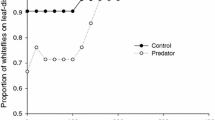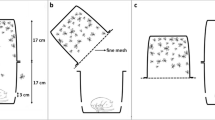Summary
Earlier feeding experiments with Drosera in the field using adult Drosophila melanogaster as prey had shown that D. intermedia reacts three times as strong with respect to biomass production as the sympatric species D. rotundifolia. The present study shows that in D. rotundifolia only 29% of added flies remain on the leaves for more than 24 h, but 95% in D. intermedia. Opportunistic predators, mostly ants, are likely to be responsible for this difference. Ants were often observed robbing food from the leaves of D. rotundifolia, and showed a much higher activity in the microhabitat of this species. In both species of Drosera larger individuals were better than smaller ones in retaining added flies. The activity of ants significantly increased with air temperature and the duration of sunshine. The advantage of plundering seems to be more important for the ants than the danger of being caught. The prey collected from Drosera may be an important source of food for bog-dwelling ants.
Similar content being viewed by others
References
China W (1953) Two new species of the genus Cyrtopeltis (Hemiptera) associated with sundews in Western Australia. West Aust Nat 4:1–9
Ellenberg H (1974) Zeigerwerte der Gafä£pflanzen Mitteleuropas. Scripta Geobotanica IX 9:5–97
Hegi G (1935) Illustrierte Flora von Mitteleuropa. Lehmanns, München
Lüttge U (1983) Encyclopedia of Plant Physiology. Physiological Plant Ecology III, New Series, Vol 12 C
Paul A, Lutz I (1941) Zur soziologisch-ökologischen Charakterisierung von Zwischenmooren. Ber Bay Bot Ges 25:1–28
Tutin TG (1968) Flora europaea. University Press, Cambridge
Thum M (1986) Segregation of habitat and prey in two carnivorous plant species, Drosera rotundifolia and Drosera intermedia. Oecologia 70:601–605
Thum M (1988a) The significance of carnivory for the fitness of Drosera in its natural habitat. 1. The reactions of Drosera intermedia and D. rotundifolia to supplementary feeding. Oecologia 75:472–480
Thum M (1988b) Untersuchungen zur Koexistenz und Nischentrennung bei zwei sympatrischen carnivoren Pflanzen, Drosera rotundifolia und Drosera intermedia. Dissertation, München
Watson AP, Mathiessen JN, Springett BP (1982) Arthropod associates and macronutrient status of the red ink sundew (Drosera erythrorhiza). Aust J Ecol 7:13–22
Wilmanns O (1978) Ökologische Pflanzensoziologie. Quelle und Meyer, Heidelberg
Author information
Authors and Affiliations
Rights and permissions
About this article
Cite this article
Thum, M. The significance of opportunistic predators for the sympatric carnivorous plant species Drosera intermedia and Drosera rotundifolia . Oecologia 81, 397–400 (1989). https://doi.org/10.1007/BF00377090
Received:
Accepted:
Issue Date:
DOI: https://doi.org/10.1007/BF00377090




